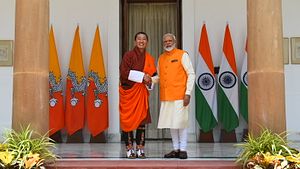What’s Behind China’s Expansion of Its Territorial Dispute With Bhutan?
Beijing may be trying to drive a wedge between India and Bhutan.
There’s no shortage of border tension currently in the Himalayas. As many Diplomat readers will be aware, India and China have been locked in their most serious border standoff since 1967 since the start of May, featuring several standoffs along multiple points in the western and Sikkim sectors of their disputed border.
The standoff reached heights unseen in decades after a June 15 melee in which 20 Indian soldiers died along with an unknown number of Chinese casualties. Meanwhile, earlier in the year, a dispute between Nepal and India over the Lipulekh border area boiled over. Now, China is apparently expanding the scope of its border dispute with the small Himalayan kingdom of Bhutan.
The Sino-Bhutanese relationship normally flies under the radar. Bhutan has the distinction of being the only other country apart from India with which China has an unsettled land border. It is also the only state to border China that does not have official diplomatic ties with Beijing. But despite this lack of official relations, the two sides have worked for years to arrive at a resolution to their border disputes, which until now primarily focused on areas in the central and western sectors.
The western sector dispute — over the Doklam plateau — has received the most attention after the 2017 India-China standoff there. The central sector disputes — over areas known as Jakarlung and Pasamlung — have received less attention comparatively. Even without formal diplomatic ties, Bhutan and China have held 24 rounds of border talks between their envoys; talks that have been frozen since their last round in 2016, partly due to the heightened tensions that erupted during the Doklam standoff. A 25th round is yet to take place.
On Saturday, the Chinese Ministry of Foreign Affairs (MFA) issued a statement to two Indian media outlets — the Hindustan Times and The Hindu — highlighting three separate areas of disputed territory with Bhutan. “The boundary between China and Bhutan has never been delimited. There have been disputes over the eastern, central and western sectors for a long time,” the Chinese MFA said, according to The Hindu.
The addition of the eastern sector is notable as this hasn’t been part of the agenda across the 24 rounds of China-Bhutan border talks. The MFA statement’s inclusion of the eastern sector came shortly after the government of Bhutan issued a demarche to China after a Chinese delegate at the 58th Global Environment Facility Council, held earlier this summer, referred to the Sakteng Wildlife Sanctuary, an area in eastern Bhutan, as disputed.
The claim itself may have some basis in history, but not one well supported by official Chinese maps. Back in 2017, in the course of studying the Sino-Indian and Sino-Bhutanese disputes over Doklam, I came across at least one older, unofficial Chinese map that portrayed a capacious dispute in the eastern sector. So, if anything, this had been a dormant Chinese claim that was ultimately — for whatever reason — deemed unsuitable for the negotiating agenda with Thimphu across 24 rounds of border talks. Now, that view has changed in Beijing. The political geography of the area in question bears underscoring: Given that India fully administers Arunachal Pradesh, even if Bhutan were to unilaterally cede this area, it would amount to an enclave without any direct border with China’s Tibet Autonomous Region.
The novelty of China’s claim in its dispute with Bhutan has already raised eyebrows, but there are other complicating factors here. First, the purported eastern sector dispute over the Sakteng Wildlife Sanctuary, in geographic terms, would be the single largest tranche of disputed territory across all sectors in the China-Bhutan context, representing about 11 percent of the territory currently administered by the Bhutanese government.
Second, the territory in question abuts the Indian state of Arunachal Pradesh, which is itself claimed in its near entirety as part of Tibet. Not only is this the case, but the Sakteng area specifically borders Arunachal’s western Tawang region, which China has particularly prioritized in negotiations with India; arguably, Tawang is the least negotiable piece of territory for Beijing in the entirety of the eastern sector. Given the ongoing Sino-Indian tensions in the western sector of their border in Ladakh, the timing of the revelation of this “new” dispute with Bhutan will likely be seen as coercive by India.
Third, given that a 25th round of China-Bhutan talks has yet to convene after the 2017 Doklam standoff, the purpose of opening this expansive — and frankly ludicrous — claim to more than 10 percent of sovereign Bhutanese territory may be primarily intended to coerce Thimphu into making concessions in other areas, such as Doklam, on terms favorable to China. Given the special relationship between India and Bhutan, as well, Chinese pressure on Bhutan may be designed to test the relationship between New Delhi and Thimphu.






No comments:
Post a Comment